
Top 25 Rankings 1901-1935
1917 National Championship
Home
1917
College Football Top 25
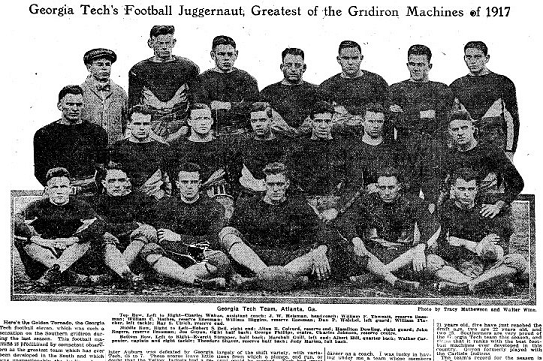
Pictured above
is part of a mid-December 1917 New York Times article declaring
9-0 Georgia Tech the best team in the country. Pittsburgh was 10-0, but
Georgia Tech had beaten 9-2 Penn 41-0, while Pitt had beaten them just
14-6, and on that basis, Georgia Tech was widely considered the
mythical national champion of 1917. I compared the teams in more detail
in my 1917 national championship article.
Georgia Tech #1, Pittsburgh #2.
#3: Ohio State vs. Penn
8-0-1 Ohio State would have been #3 in a 1917 AP poll, and 9-2 Penn would likely have been #4. Penn had a better relevant record, since their losses came to the #1 and #2 teams,
while Ohio State took their tie against a team that will not make this
top 25 (6-2-1 Auburn). But Penn only beat one team that will make this
top 25 (8-2 Michigan #14), while Ohio State defeated 3 such opponents
(5-2 Northwestern #13, 5-2-1 Illinois #10, and 4-2-1 Wisconsin #11), so
I think Ohio State will work for #3.
To get an idea how powerful
Georgia Tech was this season, in addition to beating #4 Penn 41-0, they
beat Auburn, the team that tied #3 Ohio State, 68-7.
Ohio State #3, Penn #4.
Penn
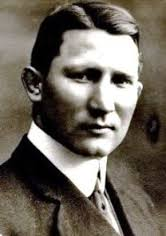
Penn was directed by Bob Folwell (pictured above), who played
halfback here 1904-1907, and went 27-10-2 as head coach 1916-1919. He
had gone 22-4-1 at Lafayette 1909-1911 and 36-5-3 at Washington &
Jefferson 1912-1915, and he would go 24-12-3 at Navy 1920-1924. Overall
he was a terrific 109-31-9, which is good enough to place him on the list for best coaching win percentage of all time. He is not in the Hall of Fame, but belongs there ahead of a great many coaches who are.
This was a very talented team. End Henry "Heinie" Miller was a
consensus All American, and would repeat as consensus AA in 1919, then
go on to a 6 year pro career. Center Lud Wray was a nonconsensus AA who
would later co-found the Philadelphia Eagles and become their first
coach. Tackle Joseph Strauss and fullback Joseph Berry, Jr. were also
nonconsensus AA.
Syracuse, Minnesota, and Rutgers
Coming next in a
1917 AP poll would likely have been 8-1-1 Syracuse, 4-1 Minnesota, and
7-1-1 Rutgers, in that order. Syracuse took their loss to #2 Pitt, and
their tie came to a military camp team composed of former college
players. They defeated 4 teams that will make this top 25, including
Rutgers, so putting them at #5 is a no-brainer. It's Minnesota being
rated ahead of Rutgers that's iffy here.
Minnesota took an upset loss (at 4-2-1 Wisconsin), while Rutgers
took an upset tie (6-3-1 West Virginia), so Rutgers was effectively
half a game better on the season. However, Wisconsin will be rated #12,
West Virginia #18, and Minnesota played Wisconsin on the road, while
Rutgers played West Virginia at home. Furthermore, Minnesota defeated 2
teams that will be rated (5-2-1 Illinois and 3-2-1 Chicago) and a third
that will be close (5-2 Indiana), and Rutgers defeated no rated teams.
But
that's because the Second Naval Reserve Station team at Newport is not
rated, since they were not a college team. That's who Rutgers played in
their finale, in front of 12,000 fans in Brooklyn, and Rutgers' 14-0
win over this team of former college all-stars was considered to be a
huge upset. Newport had demolished every team they played before this
game. Rutgers had no substitutions, and they held Newport to 2 first
downs. It was an amazing performance, and because of this, along with
Rutgers' better relevant record, the best I can offer the hypothetical
AP poll voters of 1917 is a tie.
Syracuse #5, Minnesota and Rutgers tied for #6.
Navy and Brown
Next up for a
1917 AP poll would have been 7-1 Navy, then 8-2 Brown, but we're going
to have to reverse the order there. Brown's losses came to #5 Syracuse
and to the aforementioned Newport 2nd Naval Reserves juggernaut. Navy's
loss, on the other hand, came to 6-3-1 West Virginia, so Brown was
effectively a game better on the season. Brown also defeated more teams
that will end up rated in this top 25.
I also consider it very
dubious that Navy should be rated ahead of 5-2-1 Illinois, but Illinois
had a bad finish (last 3 games were their tie and both losses), so I
let it go.
Brown #8, Navy #9.
Illinois, Wisconsin, Chicago, Northwestern, and Michigan
Next I'm
bringing in this pack of Big 10 teams. It's possible that 7-1
Georgetown, 6-1-1 Notre Dame, and/or 7-1 Army would have been rated ahead
of some or all of these teams (they had better straight records than
all of them), but I don't think any of them should have been rated
higher.
Georgetown took their loss to #9 Navy, but it was ugly (28-7), and
Georgetown did not beat a rated team. Notre Dame tied Wisconsin, but
they took a loss to 5-2 Nebraska, a team Michigan beat 20-0. And
Michigan is the low team on this Big 10 totem pole. Army, in turn, took
their loss to Notre Dame. Frankly, Notre Dame belongs ranked behind
Nebraska, who beat them.
5-2-1 Illinois started 5-0, including
wins over 6-2 Kansas, 6-4-1 Oklahoma, and 4-2-1 Wisconsin. But then
they tied 3-2-1 Chicago, and lost to #3 Ohio State and #6 Minnesota. In
addition to Illinois, 4-2-1 Wisconsin lost to #3 Ohio State, and they
were tied by Notre Dame. But on the plus side, they gave #6 Minnesota
their only loss, and they also defeated 3-2-1 Chicago.
3-2-1
Chicago took their 2nd loss to #6 Minnesota, and they tied Illinois.
They beat 5-2 Northwestern and they stomped on 5-3 Vanderbilt 48-0.
Northwestern took their other loss to #3 Ohio State. They defeated 8-2
Michigan 21-12 in their finale. 8-2 Michigan took their other loss to
#4 Penn. They defeated 8-1 Detroit 14-3 and 5-2 Nebraska 20-0.
Ultimately, it all comes down to a simple victory chain:
Illinois beat Wisconsin, who beat Chicago, who beat Northwestern, who
beat Michigan (who beat Nebraska, who beat Notre Dame, who beat Army).
Illinois #10, Wisconsin #11, Chicago #12, Northwestern #13, and Michigan #14.
Northwestern
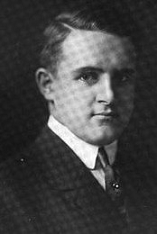
Northwestern
was coached by Fred Murphy (pictured), who had played tackle for Yale
1907-1909, winning national championships in 1907 and 1909. He guided
Northwestern to 6-1 in 1916 and 5-2 this season, but managed just
16-16-1 here 1914-1918. He moved on to Denver and Kentucky, and overall
he was 40-37-4. The star player on this year's team was fullback
Bob Koehler, All Big 10 and 2nd team AA on the Chicago Tribune list. He
went on to a 7 year pro career.
This was the year the Western
Conference became known as the "Big Ten" among the press and the
public, as it was the first time the conference had 10 members.
Michigan, who had withdrawn from the conference in 1908 in reaction to
stricter conference eligibility rules, was back this season, though the
only conference game they were playing in 1917 was at Northwestern, the
finale for both teams.
Michigan was reminded of why they had
left the conference in the first place when, in the week before the
Northwestern game, 4 Michigan players were declared ineligible to play
due to conference rules. The lost players included Oscar Lambert, their
best defensive player, and Archie Weston, their best offensive player,
and of course Michigan then went on to lose at Northwestern 21-12.Nebraska, Notre Dame, and Army
This much is
easy. 5-2 Nebraska took their losses to #14 Michigan and #5 Syracuse,
and they defeated 6-1-1 Notre Dame, who defeated 7-1 Army. 7-1
Georgetown, who did not beat any rated teams, will have to wait a bit
longer for their spot.
Nebraska #15, Notre Dame #16, and Army #17.
Nebraska
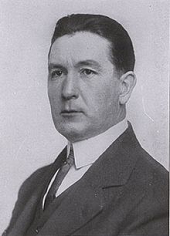
Nebraska was coached by Edward "Doc" Stewart (pictured), who went 11-4
here 1916-1917, winning conference titles both years. In fact, this
season was Nebraska's 8th straight Missouri Valley Conference title.
Stewart moved on to Clemson, Texas, and UTEP, and overall he was
76-42-14 at 7 schools. On the field, Nebraska had one nonconsensus All
American this season, end John Rasmussen.
Winning their weak conference every year was not enough for
Nebraska, and this season's non-conference slate was hellaciously
ambitious: #5 Syracuse, #14
Michigan, and #16 Notre Dame. Less ambitious was a warm-up game against
Nebraska Wesleyan, whom they beat 100-0. The conference title was
theirs after a 13-3 win at 6-2 Kansas.
West Virginia, Washington & Jefferson, and Georgetown
6-3-1 West
Virginia was quite erratic. They gave #9 Navy their only loss and they
tied #6 Rutgers, tremendous results, and they lost to #2 Pitt by just 5
points. But they also took upset losses to a pair of unrated teams, 5-3
Dartmouth and 5-2 West Virginia Wesleyan (the latter by a score of
20-0). Back on the plus side, they beat 6-2-1 Virginia Tech 27-3, 6-2-1
North Carolina State 21-0, and most importantly, they beat 7-3
Washington & Jefferson 7-0 on the road.
7-3
Washington & Jefferson took their other losses to #2 Pitt and #16
Notre Dame by 3 points each. I'm going to bring 7-1 Georgetown in
behind them for the following reasons:
- While
Georgetown might have been rated as highly as #10 in a 1917 AP poll,
due to their nice-looking straight record, they also might well have
been rated down here behind Washington & Jefferson. It's hard to
say, but W&J definitely got more attention in the press this season.
- W&J defeated 3 good unrated teams, Georgetown 2.
- W&J
was very close in all their losses, including a 3 point loss to the #2
team, whereas Georgetown was routed 28-7 by #9 Navy.
- Both teams played Washington & Lee, and W&J beat them 12-0, Georgetown 20-12.
West Virginia #18, Washington & Jefferson #19, Georgetown #20.
Texas
A&M, Washington State, Colgate, Denver, and Boston College
Next we have a
pair of token teams, 8-0 Texas A&M, the champion of the Southwest,
and 6-0-1 Washington State, the champion of the West Coast. I don't
know which would have been rated higher, as A&M had the better
record, but WSU was better known due to a Rose Bowl win over Brown
following the 1915 season. WSU's tie came against a military camp team,
so tells us nothing about them. But I'll go with A&M here, as their
10-0 win at 7-1 Rice in their finale was more impressive than any of
WSU's wins (the best of which came 6-0 at 4-2-1 Oregon State).
We have another token team, 9-0 Denver University, Rocky Mountain
champs, but they were almost completely ignored by the national press
this season, and I suspect that most writers would have known nothing
about them until they read the football annuals after the season.
Furthermore, Denver repeatedly struggled to beat mediocre-to-bad teams,
including an egregious 20-19 win at 0-8-1 Tulsa, a team that lost to
Oklahoma State by 39 and to Oklahoma by 80 over the following 2 weeks.
And Oklahoma State and Oklahoma were nowhere near top 25 material
themselves.
9-0
is 9-0, and likely would have attracted enough writers to get Denver
into the bottom of a top 25, but I'm going to bring 4-2 Colgate in
ahead of them. Colgate was certainly better known. Their losses came to
#5 Syracuse and #8 Brown, and though they didn't beat any good teams,
neither did Denver, and unlike Denver, Colgate's wins all came by big
scores.
Our last slot in this top 25 goes to 6-2 Boston College.
Their losses came to #8 Brown and #17 Army. They beat one near-rated
team (3-3 Tufts), but for the most part they look a lot like Colgate.
But Colgate was coming off a national championship contending season in
1916, and was thus better known. BC was considered a mid-major or even
a minor team at this time, which is why I think Denver would
have been rated higher, as a token Rocky Mountain team.
In
fact, there's a very good chance that 5-3 Dartmouth would have gotten
this slot over 6-2 Boston College in a 1917 AP poll. Dartmouth beat #18
West Virginia, but they also lost to unrated 3-3 Tufts, and by a score
of 27-0. BC beat Tufts 20-0. And Dartmouth's 3 losses were their last 3
games, the finale coming 13-0 against Brown. BC lost to Brown by just 5
points. So I can't see rating Dartmouth ahead of BC at all.
Texas A&M #21, Washington State #22, Colgate #23, Denver #24, and Boston College #25.
Others
Receiving Votes
Here
are the teams closest to making this top 25. 2-0 Princeton and 3-0 Yale
were too withdrawn from major football play, due to the impending world
war, to be considered. Similarly, 8-0-1 Marquette and 7-0-1 Williams
played schedules that were too distant from major football play for
them to be considered.
Dartmouth 5-3
5-3 Dartmouth
upset #18 West Virginia, but they dropped their last 3 games to #4
Penn, #8 Brown, and most damagingly, to unrated 3-3 Tufts (discussed
below) by a score of 27-0.
Lehigh 7-2
7-2 Lehigh took
their losses to #2 Pitt and #20 Georgetown, neither game close. They
beat 5-4 Penn State 9-0, and they rolled up 78 points on rival
Lafayette in their finale.
Washington & Lee 4-3
Based in
Virginia, 4-3 Washington & Lee was the second best team in the
South this season behind #1 Georgia Tech. Their losses came to #1
Georgia Tech (63-0), #19 Washington & Jefferson, and #20
Georgetown. They beat 6-2-1 North Carolina State 28-7, and they scored
118 points on Roanoke.
Rice 7-1
7-1 Rice won
easily over every team they played this season until a 10-0 loss to #21
Texas A&M at home in their finale. They won 26-0 over 8-2 TCU and
16-0 at 5-3 Tulane.
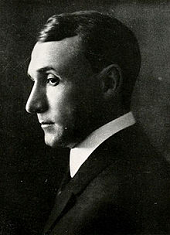
Rice
was coached by Phil Arbuckle (pictured), who became the school's
first-ever football coach in 1912. He would guide them to 8-1 in 1919,
and in all he went 51-25-8 at Rice 1912-1923, giving him the highest
winning percentage of any football coach in Rice's history. Throw in a
couple of losing stints at Southwestern (Texas) and Louisiana Tech, and
his total was 60-44-14.
Kansas 6-2
6-2 Kansas took
their losses to #10 Illinois and #15 Nebraska. They defeated 5-2 Iowa
State, 6-2 Kansas State, and 6-4-1 Oklahoma.
Kansas
was coached by Herman Olcott, who had played center for Yale 1900-1901,
winning a national championship in 1900. He was 16-7-1 here 1915-1917,
and overall he was 45-30-11 at 3 schools.
Detroit 8-1
8-1 Detroit took
their loss 14-3 at #14 Michigan. They beat no one of value, but no one
else got close to them, and they annihilated Toledo 145-0.
Indiana 5-2
5-2 Indiana was
trounced by #3 Ohio State and #6 Minnesota. Like Detroit, they beat no
one of value, but all their wins came by huge scores.
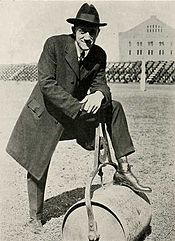
Indiana
was coached by Ewald "Jumbo" Stiehm, and his teams were often called
the Stiehm-Rollers, here and in previous years at Nebraska (thus the
picture of him above posing with a stream roller). He had played center
for Wisconsin 1906-1908, and had made a name for himself as coach at
Nebraska 1911-1915, winning conference titles every year and going an
amazing 35-2-3. Indiana hired him away in 1916 to do the same for them,
but he was unable to replicate his Nebraska success. Still, he did go
20-18-1 here 1916-1921, making him one of the few football coaches in
Indiana history to manage a winning record. Overall, Stiehm was 59-23-4
at 3 schools.
Indiana was led on the field by all-conference
center Russell Hathaway, who would go on to a 7 year pro career.
Indiana's 32.1 points per game this season stood as a school record all
the way to 1988! Indiana didn't beat anyone who was particularly good
this year, but their finale at rival Purdue was pretty big, not just
because it was a rivalry, but because of how it all went down.
On
the Monday before the game, Purdue demanded that Indiana declare 2 of
their starters ineligible, one for playing a pro game, and one for
playing baseball at Creighton the previous season, for which he should
sit out a year after transferring. Purdue was correct, but they had
purposefully waited until this week to say anything, and Indiana
players therefore refused to play the game. Only 12 players had shown
up for practice for Indiana at the beginning of the season, and only 14
were on the roster by this point, so losing a pair of starters was
quite a blow.
Indiana did not practice all week, but on Thursday
the school president implored them to play the game for Indiana's
honor, and the players voted again, this time agreeing to go ahead and
play the game. Everyone was smoke-snorting mad, and Stiehm's pregame
speech sent them into a frenzy, resulting in a 37-0 whipping of Purdue.
Still, resentment lingered, and Indiana would not play Purdue again
until 1920. The series has continued unabated since then.
Tufts 3-3
Little 3-3 Tufts
took their losses to #5 Syracuse, #17 Army, and #25 Boston College, all
by big scores, but they make this list because they romped 5-3
Dartmouth (covered above) 27-0. This wasn't the first time Tufts made
news: they had upset a powerful Harvard team the previous season.
1917
Top 25
1)
Georgia Tech 9-0
2) Pittsburgh 10-0
3) Ohio State 8-0-1
4) Pennsylvania 9-2
5) Syracuse 8-1-1
6) Minnesota 4-1
Rutgers 7-1-1
8) Brown 8-2
9) Navy 7-1
10) Illinois 5-2-1
11) Wisconsin 4-2-1
12) Chicago 3-2-1
13) Northwestern 5-2
14) Michigan 8-2
15) Nebraska 5-2
16) Notre Dame 6-1-1
17) Army 7-1
18) West Virginia 6-3-1
19) Washington & Jefferson 7-3
20) Georgetown 7-1
21) Texas A&M 8-0
22) Washington State 6-0-1
23) Colgate 4-2
24) Denver 9-0
25) Boston College 6-2
Others
Receiving Votes:
Dartmouth 5-3
Lehigh 7-2
Washington & Lee 4-3
Rice 7-1
Kansas 6-2
Detroit 8-1
Indiana 5-2
Tufts 3-3






